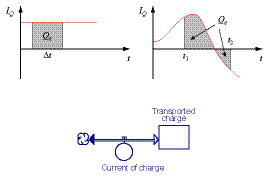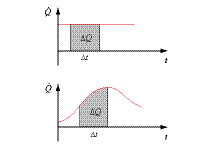1. Quantities and Mathematical Operations | |

| |
Primitives Quantity of electricity: Charge. The unit of electric charge is called the Coulomb (C). Remember that electric charge can be either positive or negative (Figure 1), and positive charge cancels the effects of negative charge (the sum of equal amounts of positive and negative charge is zero). Electric charge can neither be produced nor destroyed. Electric charge is the source of electric fields which are immaterial objects with particular properties that affect other fields and matter. Most simply, fields explain interactions that appear to take place at a distance (without the direct interaction of material objects). Charge is quantized: There is a smallest quantity of charge in nature called the elementary charge. This smallest quantity is the amount possessed by protons and electrons, for example. Protons carry one positive elementary amount of charge, whereas the charge of an electron is one negative elementary amount. The elementary charge is 1.60·10–19 Coulomb. |

Figure 1 |
Current of electric charge. The current of charge (electric current, or simply current) describes the flow of electric through materials. The current allows us to calculate how much charge is transported in a given period of time. The unit of electric current is C/s which has its own name—Ampere (A). We use the symbol I_Q to denote a flow of charge. In processes, the current is a function of time (Figure 2). |

Figure 2 |
Electric potential. The electric potential measures the intensity of the electric state of a system at a point (bodies and electric fields). Its unit is V (Volt), the symbol used is phi_el. It is analogous to pressure in fluids. Electric potential does not have an absolute zero point (in contrast to pressure). Electric potential differences are called voltage. By itself, positive electric charge will flow from points of high to low electric potential, whereas electrons flow from low to high electric potential. | |
Derived quantities Change of charge. The change of charge of a system over a period of time is defined as the difference between the later and the earlier values:
Rate of change of charge. The rate of change of charge describes how fast the charge of a system changes (Figure 3). Symbols are dQ/dt or Q with a dot above it (pronounced Q-dot). The unit of rate of change of charge is C/s. The rate of change is determined graphically from the slope of tangents at points of the curve in the charge-time diagram. Transported charge. If we know a current of charge as a function of time, we can determine the transported or exchanged amount of charge with this flow (Figure 4, symbol Q_e). Graphically, the transported charge corresponds to areas between the curve and the time axis for an interval of time from, say, t1 to t2. The mathematical operation is called integration of the current over time: From rate of change of volume to volume. If the rate of change of charge stored in a system is known, we can calculate the change of charge occurring during a period of time (Figure 5). The mathematical procedure is that of integration: If we know the initial value of charge, we can calculate Q as a function of time. |

Figure 3

Figure 4

Figure 5
|
Voltage: the difference of electric potentials. The potential difference is the difference of potentials at two different points A and B of a system, independent of the physical reasons for the difference. Usually, it is defined as later minus earlier in a chosen direction: The negative potential difference is called the voltage between points A and B: This means that the voltage is positive across a resistor in the direction of the flow of (positive) charge, whereas it is negative across a battery in the direction of flow. |
|






